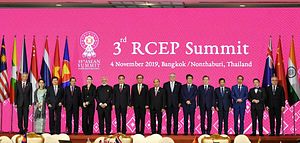India’s recent withdrawal from the Regional Comprehensive Economic Partnership (RCEP) negotiations is a setback for economic integration in the Indo-Pacific.
Originally comprising 16 economies that account for around a third of world GDP, RCEP would have had a systemic impact on the global economic architecture. As the first regional trade agreement to include India, it would have also been the first economic manifestation of the Indo-Pacific concept.
But what happens next for this mega-regional trade agreement? Can, as some have argued, negotiations be completed as an “RCEP-15” in 2020? Or will India’s withdrawal send negotiators back to the starting line?
The outcome now depends on how the Japanese government will approach India’s withdrawal. And this is indicative of a new role for Japan as a kingmaker for regional trade agreements in the Indo-Pacific.
Japan is particularly invested in India’s inclusion in RCEP. It was responsible for the “ASEAN+6” membership of the agreement, which Tokyo successfully promoted in 2012 in the face of a competing Chinese “ASEAN+3” proposal that would have excluded India, Australia, and New Zealand. Japan has been one of the leading advocates for the Indo-Pacific concept, which seeks to better integrate India into regional architectures. Japan and India have also rapidly upgraded their bilateral relationship in recent years, to which a “two-plus-two” defense and foreign ministers meeting was added in November.
India’s RCEP withdrawal is thus a major strategic loss for Japanese diplomacy.
This concern is reflected in Japan’s official response. When asked whether RCEP would proceed without India, Japan’s lead negotiator indicated: “We aren’t thinking about that at all yet… Japan will continue to try to persuade India to join.” Subsequent efforts to reach out directly to India were then mooted for a Japan-India prime ministerial summit scheduled for December 15. However, protests related to India’s recent change to citizenship laws have now seen the summit indefinitely postponed.
In any event, it is highly unlikely that Japan would be able to convince India to rejoin the negotiations. An India-China deadlock over their trade balance has held up negotiations for several years, and Indian requests for special India-China bilateral arrangements have been opposed. Indian Prime Minister Narendra Modi’s statement on withdrawal was decidedly unequivocal:
The present form of the RCEP Agreement does not fully reflect the basic spirt and the agreed guiding principles of RCEP. It also does not address satisfactorily India’s outstanding issues and concerns. In such a situation, it is not possible for India to join RCEP Agreement.
By contrast, the remaining members intend to press on. The most-recent RCEP Leaders’ Statement noted that 15 countries have now concluded their text-based negotiations and most tariff issues. The current target is for signing of the legally-scrubbed text in February 2020.
Japan now faces a difficult trade-off between strategic and economic objectives: Should Tokyo refuse to sign RCEP without India, a move that may terminally compromise the entire agreement? Or should it proceed on a 15-member basis, and secure a systemically-important trade pact for the Indo-Pacific?
Indeed, Japan found itself in this very position during recent negotiations for the Trans-Pacific Partnership (TPP). When President Donald Trump withdrew the United States in early 2017, many commentators concluded the TPP was dead. Strategic objectives saw Japan initially tried to coax Trump back into the agreement, with no success. However, Japanese diplomacy then pivoted toward the economic, launching moves to finalize the TPP without its largest market. Tokyo led and organized a coalition of like-minded partners to salvage the agreement, and the 11-member Comprehensive and Progressive Agreement for Trans-Pacific Partnership (CPTPP) was completed only a year later.
Japan was able to push the TPP-11 over the line because it has many of the attributes required for trade diplomacy leadership. As the world’s third largest economy, its market is of a sufficient size to offer serious negotiating coin in discussion with partners. It has trusted diplomatic relationships with most countries in the Indo-Pacific, particularly amongst the ASEAN states. And it has a demonstrated capability to compromise, evident in its willingness to include (domestically sensitive) agriculture sectors in the TPP.
Moreover, Japan is arguably the only country capable of regional trade leadership at the moment. The Trump administration’s coercive trade practices have lowered trust with partners, and excluded it from key multilateral negotiations. Other pro-liberalization players – such as Singapore, Thailand, and Australia – lack the economic or diplomatic heft to lead. And China brings complicated and sometimes conflictual geopolitical issues to the table, evident in the anti-China sentiments that have played a part of India’s debate on RCEP.
For the second time in only two years, Japan finds itself the kingmaker for a mega-regional trade deal of systemic global impact. Whether it now chooses to prioritize strategic or economic objectives will likely determine the future of the Indo-Pacific economic architecture.
Dr. Jeffrey Wilson is the Research Director at the Perth USAsia Centre.

































